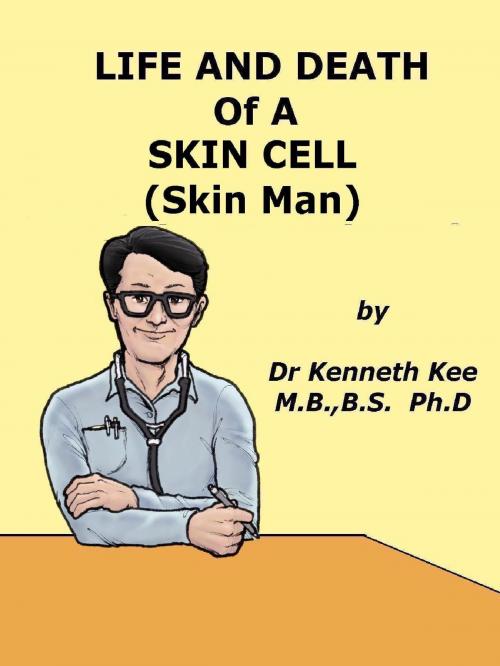Life And Death Of A Skin Cell (Skin Man)
Nonfiction, Health & Well Being, Medical, Specialties, Dermatology, Health, Ailments & Diseases, Skin| Author: | Kenneth Kee | ISBN: | 9781310516061 |
| Publisher: | Kenneth Kee | Publication: | December 18, 2014 |
| Imprint: | Smashwords Edition | Language: | English |
| Author: | Kenneth Kee |
| ISBN: | 9781310516061 |
| Publisher: | Kenneth Kee |
| Publication: | December 18, 2014 |
| Imprint: | Smashwords Edition |
| Language: | English |
My name is Skin Man the Skin Cell.
I was named Skin Man by my friends who feel that Skin Man is the name of a cell from the largest organ of the human body.
The only cells in the early human embryo are precursor cells or stem cells that are nudged into becoming specialized bone, nerve, internal organ or skin cells by the action of genes and the growth-and-development molecules produced by genes.
It may be surprising to learn that we skin cells have a developmental relationship with many others tissues such as breast and prostate gland but this shows the built-in potential of stem cells to grow into a variety of specialized forms.
We Skin cells do not just spring into existence from embryo stem cells.
The path of our development begins in a group of stem cells that are nudged into different directions to become specialized cells of many different tissues and organs including skin.
The paraxial mesoderm is divided along the embryo's length into somites, corresponding to the segmentation of the body.
-
Sclerotome (which forms vertebrae),
-
Dermatome (which forms skin), and
-
Myotome (which forms muscle).
It has long been known that we skin cell development begins in the dermatome of the very early embryo before the embryo begins to mature into the recognizably human form of a fetus.
The skin is the largest organ of the body with a total area of about 20 square feet.
My skin protects us from microbes and the elements, helps regulate body temperature, and permits the sensations of touch, heat, and cold.
My Skin has three layers:
The epidermis, the outermost layer of skin, provides a waterproof barrier and creates our skin tone.
The dermis, beneath the epidermis, contains tough connective tissue, hair follicles, and sweat glands.
The deeper subcutaneous tissue (hypodermis) is made of fat and connective tissue.
My skin’s color is created by my special cells called melanocytes which produce the pigment melanin.
My melanocytes are located in the epidermis.
Melanin produced by my melanocytes comes in two types:
-
Pheomelanin (red)
-
Eumelanin (dark brown to nearly black).
Red and brown pigments are in our skin cells.
My actual skin color is just going to be a mix of these colors in varying degrees.
Having a higher concentration of these colors means that the melanins are closer together and my skin is darker.
People that are even closely related can have different skin tones.
There is a difference in skin color in people all around the world.
This is important as skin color can give rise to discrimination between people of various skin colors such as so-called white supremacy.
Sometimes the absence of my melanocytes result in melanin being produced and an albino is the result –white hair and pale skin.
My Skin cells are constantly being regenerated.
I was born in the lower layer of the skin called the dermis, which is supplied with blood vessels and nerve ending.
My skin cell migrates upward for about two weeks until it reaches the bottom portion of the epidermis, which is the outermost skin layer.
The epidermis does not have blood vessels but does have nerve endings.
My skin cell spends another two weeks in the epidermis gradually flattening out and continuing to move toward the surface.
There I will die and will be shed.
TABLE OF CONTENT
Chapter 1 Story of Skin Man
Chapter 2 Life Cycle of Skin Cell
Chapter 3 Formation of a Skin Cell
Chapter 4 Death of a Skin Cell
Chapter 5 Eczema
My name is Skin Man the Skin Cell.
I was named Skin Man by my friends who feel that Skin Man is the name of a cell from the largest organ of the human body.
The only cells in the early human embryo are precursor cells or stem cells that are nudged into becoming specialized bone, nerve, internal organ or skin cells by the action of genes and the growth-and-development molecules produced by genes.
It may be surprising to learn that we skin cells have a developmental relationship with many others tissues such as breast and prostate gland but this shows the built-in potential of stem cells to grow into a variety of specialized forms.
We Skin cells do not just spring into existence from embryo stem cells.
The path of our development begins in a group of stem cells that are nudged into different directions to become specialized cells of many different tissues and organs including skin.
The paraxial mesoderm is divided along the embryo's length into somites, corresponding to the segmentation of the body.
-
Sclerotome (which forms vertebrae),
-
Dermatome (which forms skin), and
-
Myotome (which forms muscle).
It has long been known that we skin cell development begins in the dermatome of the very early embryo before the embryo begins to mature into the recognizably human form of a fetus.
The skin is the largest organ of the body with a total area of about 20 square feet.
My skin protects us from microbes and the elements, helps regulate body temperature, and permits the sensations of touch, heat, and cold.
My Skin has three layers:
The epidermis, the outermost layer of skin, provides a waterproof barrier and creates our skin tone.
The dermis, beneath the epidermis, contains tough connective tissue, hair follicles, and sweat glands.
The deeper subcutaneous tissue (hypodermis) is made of fat and connective tissue.
My skin’s color is created by my special cells called melanocytes which produce the pigment melanin.
My melanocytes are located in the epidermis.
Melanin produced by my melanocytes comes in two types:
-
Pheomelanin (red)
-
Eumelanin (dark brown to nearly black).
Red and brown pigments are in our skin cells.
My actual skin color is just going to be a mix of these colors in varying degrees.
Having a higher concentration of these colors means that the melanins are closer together and my skin is darker.
People that are even closely related can have different skin tones.
There is a difference in skin color in people all around the world.
This is important as skin color can give rise to discrimination between people of various skin colors such as so-called white supremacy.
Sometimes the absence of my melanocytes result in melanin being produced and an albino is the result –white hair and pale skin.
My Skin cells are constantly being regenerated.
I was born in the lower layer of the skin called the dermis, which is supplied with blood vessels and nerve ending.
My skin cell migrates upward for about two weeks until it reaches the bottom portion of the epidermis, which is the outermost skin layer.
The epidermis does not have blood vessels but does have nerve endings.
My skin cell spends another two weeks in the epidermis gradually flattening out and continuing to move toward the surface.
There I will die and will be shed.
TABLE OF CONTENT
Chapter 1 Story of Skin Man
Chapter 2 Life Cycle of Skin Cell
Chapter 3 Formation of a Skin Cell
Chapter 4 Death of a Skin Cell
Chapter 5 Eczema















